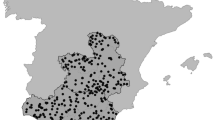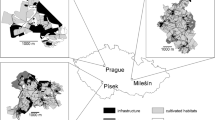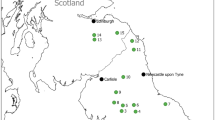Abstract
In Morocco, the barbary partridge (Alectoris barbara) is the major game species, highly valued by the nation’s hunters. Until recently little was known about factors affecting reproductive parameters of this species on cereal croplands in North Africa. In 2018, 51 nests were found and analyzed across two agricultural areas of Northwestrn Morocco (AGR1 and AGR2). In this work, I assessed the relevance of a set of environmental and anthropogenic variables in predicting the clutch size and number of chicks hatched per nest, by means of generalised linear mixed models (GLMM). The average clutch size and hatching success per nest were 12.26 (± 0.57) and 9.26 (± 0.95), respectively. In the two sites, clutch-size increased as the date advanced, but was significantly larger in AGR1 (13.17 ± 0.84, n = 26) than in AGR2 (11.20 ± 0.70, n = 25). The number of chicks hatched per nest increased over time but also with the increase of the vegetation cover at fine-scale. Barbary partridge reproductive parameters were neither affected by landscape nor anthropogenic variables. I discuss these findings and their ecological, and future research implications. I recommended to pursuit the investigations, while considering imperatively the age/sex ratios and predation pressure.

Similar content being viewed by others
References
Akil M (1998) Dynamique des populations de la Perdrix Gambra (Alectoris barbara) dans la région de Yakouren (Algérie). Mémoire de Magister. Inst. Sci. Nat., Univ. Tizi-ouzou
Akil M, Boudedja S (1996) La Perdrix gambra (Alectoris barbara) Rev. La Fôret Algérienne. Inst Nat For 1:31–36
Alaoui MY (1992) Écologie de la ponte chez la Perdrix Gambra (Alectoris barbara) au Maroc. Gibier Faune Sauvage 9:405–415
Alaoui MY (2001) Mise en évidence d’une race de montagne de Perdrix Gambra (Alectoris barbara) dans le haut-atlas marocain. Game Wildl Sci 18:451–457
Bartoń K (2015) MuMIn: multi-model inference. R package version 1.9.13. Available at http://CRAN.R http://project.org/package=MuMIn. Accessed 13 Sept 2018
Bates D, Maechler M, Bolker B, Walker S (2014) lme4: linear mixed-ef-fects models using Eigen and S4. R package version 1.1–7. http://cran.r-project.org/package=lme4. Accessed 13 Sept 2018
BirdLife International (2004) Birds in Europe: population estimates, trends and conservation status. BirdLife International, Cambridge
Boukrabouza A (2011) Connaissance, conservation et gestion des populations de la Perdrix Gambra (Alectoris barbara Bonnaterre, 1792) au niveau de la réserve de chasse de Zéralda. Mémoire PGS. Université S.T.H.B.
Breheny P, Burchett W (2012) Visualizing regression models using visreg. http://web.as.uky.edu/statistics/users/pbreheny/publications/visreg.pdf. Accessed 16 Sept 2018
Bro E, Reitz F, Clobert J (2000) Nest-site selection of Grey partridge (Perdix perdix) on agricultural lands in North-Central France. Game Wildl Sci 17:1–16
Burnham KP, Anderson DR (2002) Model selection and multimodel inference: a practical information theoretic approach. Springer, New York
Cambardella CA, Moorman TV, Novak JM, Parkin TB, Karlen DL, Turco RF, Konopka AE (1994) Field-scale variability of soil properties in Central Iowa soils. Soil Sci Soc Am J 58:1501–1511. https://doi.org/10.2136/sssaj1994.03615995005800050033x
Casas F, Mougeot F, Viñuela J (2009) Double nesting behaviour and differences between sexes in breeding success in wild Red-legged Partridges Alectoris rufa. Ibis 151:743–751. https://doi.org/10.1111/j.1474-919X.2009.00958.x
Cherkaoui SI, Hanane S (2018) Evidence for a geographical gradient selection in the distribution of breeding Podicipedidae and Rallidae in the South-Western Mediterranean. J Nat Hist 52:2457–2472. https://doi.org/10.1080/00222933.2018.1539195
Clifford LD, Anderson DJ (2001) Food limitation explains most clutch size variation in the Nazca booby. J Animal Ecol 70:539–545. https://doi.org/10.1046/j.1365-2656.2001.00521.x
Davis SK (2005) Nest-site selection patterns and the influence of vegetation on nest survival of mixed-grass prairie passerines. Condor 107:605–616. https://doi.org/10.1650/0010-5422(2005)107[0605:NSPATI]2.0.CO;2
Dormann CF (2007) Effects of incorporating spatial autocorrelation into the analysis of species distribution data. Glob Ecol Biogeogr 16:129–138. https://doi.org/10.1111/j.1466-8238.2006.00279.x
Enck JW (1987) The effect of insect abundance on gray partridge chick survivorship in New York. In: Kimmel RO, Schulz JW, Mitchell GJ (eds), Perdix IV: Gray Partridge Workshop. Minn. Dep. of Nat. Res., Madelia, pp 3–15
Evans KL, Duncan RP, Blackburn TM, Crick HQP (2005) Investigating geographic variation in clutch size using natural experiment. Funct Ecol 19:616–624. https://doi.org/10.1111/j.1365-2435.2005.01016.x
Faria N, Morales MB, Rabaça JE (2016) Exploring nest destruction and bird mortality in mown Mediterranean dry grasslands: an increasing threat to grassland bird conservation. Eur J Wildl 62:663–671. https://doi.org/10.1007/s10344-016-1039-4
Foronda P, Casanova J, Figueruelo E, Abreu N, Feliu C (2005) The helminth fauna of the barbary partridge Alectoris barbara in Tenerife, Canary Islands. J Helminthol 79:133–138. https://doi.org/10.1079/JOH2005277
Fowler (1995) Stages of age-related reproductive success in birds: simultaneous effects of age, pair-bond duration and reproductive experience. Amer Zool 35:318–328. https://doi.org/10.1093/icb/35.4.318
Fox AD, Kuhlmann Clausen K, Dalby L, Christensen TK, Sunde P (2015) Age-ratio bias among hunter-based surveys of Eurasian wigeon Anas penelope based on wing vs field samples. Ibis 157:391–395. https://doi.org/10.1111/ibi.12229
Fuller RJ, Gregory RD, Gibbons DW, Marchant JH, Wilson JD, Baillie SR, Carter N (1995) Population declines and range contractions among lowland farmland birds in Britain. Conserv Biol 9:1425–1441. https://doi.org/10.1046/j.1523-1739.1995.09061425.x
Green RE (1984) The feeding ecology and survival of partridge chicks (Alectoris rufa and Perdix perdix) on arable farmland in East Anglia. J Appl Ecol 21:817–830. https://doi.org/10.2307/2405049
Gruychev G (2012) Results from radio-telemetric monitoring of hand-reared and released Chukar partridges (Alectoris chukar Gray, 1830). Acta Zool Bulg 64:59–65
Guillemain M, Fox AD, Pöysä H, Väänänen VM, Christensen TK, Triplet P, Schricke V, Korner-Nievergelt F (2013) Autumn survival inferred from wing age ratios: wigeon juvenile survival half that of adults at best? J Ornithol 154:351–358. https://doi.org/10.1007/s10336-012-0899-y
Hanane S (2018) Local- versus landscape-scale determinants of nest-site selection in a north African population of barbary partridge (Alectoris Barbara). Bird Study 65:495–504. https://doi.org/10.1080/00063657.2018.1559797
Hořák D, Sedláček O, Tószögyová A, Albrecht T, Ferenc M, Jelínek V, Storch D (2011) Geographic variation in avian clutch size and nest predation risk along a productivity gradient in South Africa. Ostrich 82:175–183. https://doi.org/10.2989/00306525.2011.607863
Isenmann P, Moali A (2000) Les Oiseaux d’Algérie. [Birds of Algeria.]. Société d’Étude Ornithologiques de France, Paris
Isenmann P, Gaultier T, El Hili A, Azafzaf H, Dlensi H, Smart M (2005) Oiseaux de Tunisie. SEOF Editions, Paris
Krüger H, Väänänen VM, Holopainen S, Nummi P (2018) The new faces of nest predation in agricultural landscapes—a wildlife camera survey with artificial nests. Eur J Wildl 64. https://doi.org/10.1007/s10344-018-1233-7
Liu M, Rubenstein DR, Cheong SA, Shen SF (2018) Multitasking and the evolution of optimal clutch size in fluctuating environments. Ecol Evol 8:8803–8817. https://doi.org/10.1002/ece3.4364
Madge S, McGowan P (2002) Pheasants, partridges and grouse: including buttonquails, sandgrouse and allies. Christopher Helm, London
Maghnouj M (1983) Contribution à l’étude de l’écologie et de la biologie de la reproduction de la Perdrix gambra (Alectoris barbara B.) dans trois régions du Maroc. Mémoire 3ème cycle, Inst. Agro. Vét. Hassan II, Rabat
Maghnouj M (1990) Une reproduction naturelle satisfaisante de la Perdrix gambra (Alectoris barbara). Division de Recherches et d’Expérimentations Forestières, Rabat
Mezerdi, F. 2011. Connaissance, conservation et gestion de la population de la Perdrix gambra (Alectoris barbara Bonnaterre, 1792) en Algérie. Mémoire de Magister. Université Mohamed Khider de Biskra
Mezerdi, F. 2015. Biologie de la reproduction d’une population captive de la Perdrix gambra (Alectoris barbara) et dynamique des populations en milieux prés forestiers et présahariens en Algérie. Thèse de Doctorat, Université Mohamed Khider de Biskra
Montagna D, Meriggi A (1991) Population dynamics of grey partridge (Perdix perdix) in northern Italy. Italian J Zool 58:151–155. https://doi.org/10.1080/11250009109355746
Nadal J, Ponz C, Margalida A (2018) Population age structure as an indicator for assessing the quality of breeding areas of common quail (Coturnix coturnix). Ecol Indic 93:1136–1142. https://doi.org/10.1016/j.ecolind.2018.06.010
Nakagawa S, Schielzeth H (2013) A general and simple method for obtaining R^2 from generalized linear mixed-effects models. Methods Ecol Evol 4:133–142. https://doi.org/10.1111/j.2041-210x.2012.00261.x
Newton I (1979) Population ecology of raptors. Buteo Books; Vermillion, SD, USA
Ong-in T, Pierce AJ, Gale GA, Browne SJ, Savini T (2016) Nesting ecology and nest site selection of green-legged partridge. Raffles Bull Zool 64:89–97
Pebesma EJ 2006. The gstat package. http://www.gstat.org. Accessed 13 Sept 2018
Ponce C, Salgado I, Bravo C, Gutiérrez N, Alonso JC (2018) Effects of farming practices on nesting success of steppe birds in dry cereal farmland. Eur J Wildl 64. https://doi.org/10.1007/s10344-018-1167-0
Potts GR (1980) The effects of modern agriculture, Nest predation and game management on the population ecology of partridges (Perdix perdix and Alectoris rufa). Adv Ecol Res 11:1–79. https://doi.org/10.1016/S0065-2504(08)60266-4
Potts GR (1986) The partridge. Pesticides, predation and conservation. Collins, London
Potts GR (2013) Some differences in the breeding ecology of Alectoris and Perdix partridges and implications for the conservation of Alectoris: a review. Avocetta 37:107–110
Quinn GP, Keough MJ (2002) Experimental design and data analysis for biologists. Cambridge University Press, Cambridge
R Development Core Team 2013. R: a language and environment for statistical computing. R Foundation for Statistical Computing, Vienna. http://www.R-project.org
Reitz F, le Goff E, Fuzeau M (2002) Landscape selection by grey partridge (Perdix perdix) for nesting in the fields of French cereal agrosystems. Game Wildl Sci 19:209–220
Ricci JC (1985) Utilization de quelques resources du milieu par les nichées de Perdrix rouge (Alectoris rufa) dans un agrosystème de type polycolture élevage. Gibier Faune Sauv 2:15–38
Ricci JC, Mathon JF, Garcia A, Berger F, Esteve JP (1990) Effect of habitat structure and nest site selection on nest predation in red-legged partridges (Alectoris rufa L.) in French Mediterranean farmlands. Gibier Faune Sauv 7:231–253
Robinson SK, Thompson FR, Donovan TM, Whitehead DR, Faaborg J (1995) Regional forest fragmentation and the nesting success of migratory birds. Science 267:1987–1990. https://doi.org/10.1126/science.267.5206.1987
Rodriguez-Teijeiro J, Sardà-Palomera F, Nadal J, Ferrer X, Ponz C, Puigcerver M (2009) The effects of mowing and agricultural landscape management on population movements of the common quail. J Biogeogr 36:1891–1898. https://doi.org/10.1111/j.1365-2699.2009.02109.x
Setchfield RP, Peach W (2016) The influence of crop tiller density on the breeding performance of a cerealnesting specialist. J Appl Ecol 53:1430–1439. https://doi.org/10.1111/1365-2664.12704
Souchay G, Besnard A, Perrot C, Jakob C, Ponce-Boutin F (2018) Anthropic and natural factors drive variation of survival in the red-legged partridge in southern France. Wildl Biol. https://doi.org/10.2981/wlb.00438.10.2981/wlb.00438
Spottiswoode CN (2009) Fine-scale life-history variation in sociable weavers in relation to colony size. J Animal Ecol 78:504–512. https://doi.org/10.1111/j.1365-2656.2008.01507.x
Stanton RL, Morrissey CA, Clark RG (2018) Analysis of trends and agricultural drivers of farmland bird declines in North America: a review. Agric Ecosyst Environ 254:244–254. https://doi.org/10.1016/j.agee.2017.11.028
Steenhof K, Newton I (2007) Assessing raptor nest success and productivity. In: Bird DM, Bildstein KL (eds) Raptor Management and Research Techniques. Hancock House, Blaine, pp 181–192
Thévenot M, Vernon JDR, Bergier P (2003) The birds of Morocco: an annotated checklist. BOU Check-listno. 20. Tring: British Ornithologists’ Union
Venables WN, Ripley BD (2002) Modern applied statistics with S, 2nd edn. Springer, New York
Wilcoxen CA, Walk JW, Ward MP (2018) Use of cover crop fields by migratory and resident birds. Agric Ecosyst Environ 252:42–50. https://doi.org/10.1016/j.agee.2017.09.039
Zuur AF, Ieno EN, Walker NJ, Saveliev AA, Smith GM (2009) Mixed effects models and extensions in ecology with R. Springer, New York
Acknowledgements
I thank all collaborators for helping during the field work. I also thank two anonymous reviewers and the Editor of Biologia Journal for their comments and advice.
Author information
Authors and Affiliations
Corresponding author
Ethics declarations
Conflict of interest
The author declares that he has no conflicts of interest.
Additional information
Publisher’s note
Springer Nature remains neutral with regard to jurisdictional claims in published maps and institutional affiliations.
Rights and permissions
About this article
Cite this article
Hanane, S. Factors affecting the reproductive performance of barbary partridges in cereal croplands of Northwestern Morocco: the role of timing of breeding and vegetation cover at fine-scale. Biologia 75, 235–241 (2020). https://doi.org/10.2478/s11756-019-00290-3
Received:
Accepted:
Published:
Issue Date:
DOI: https://doi.org/10.2478/s11756-019-00290-3




